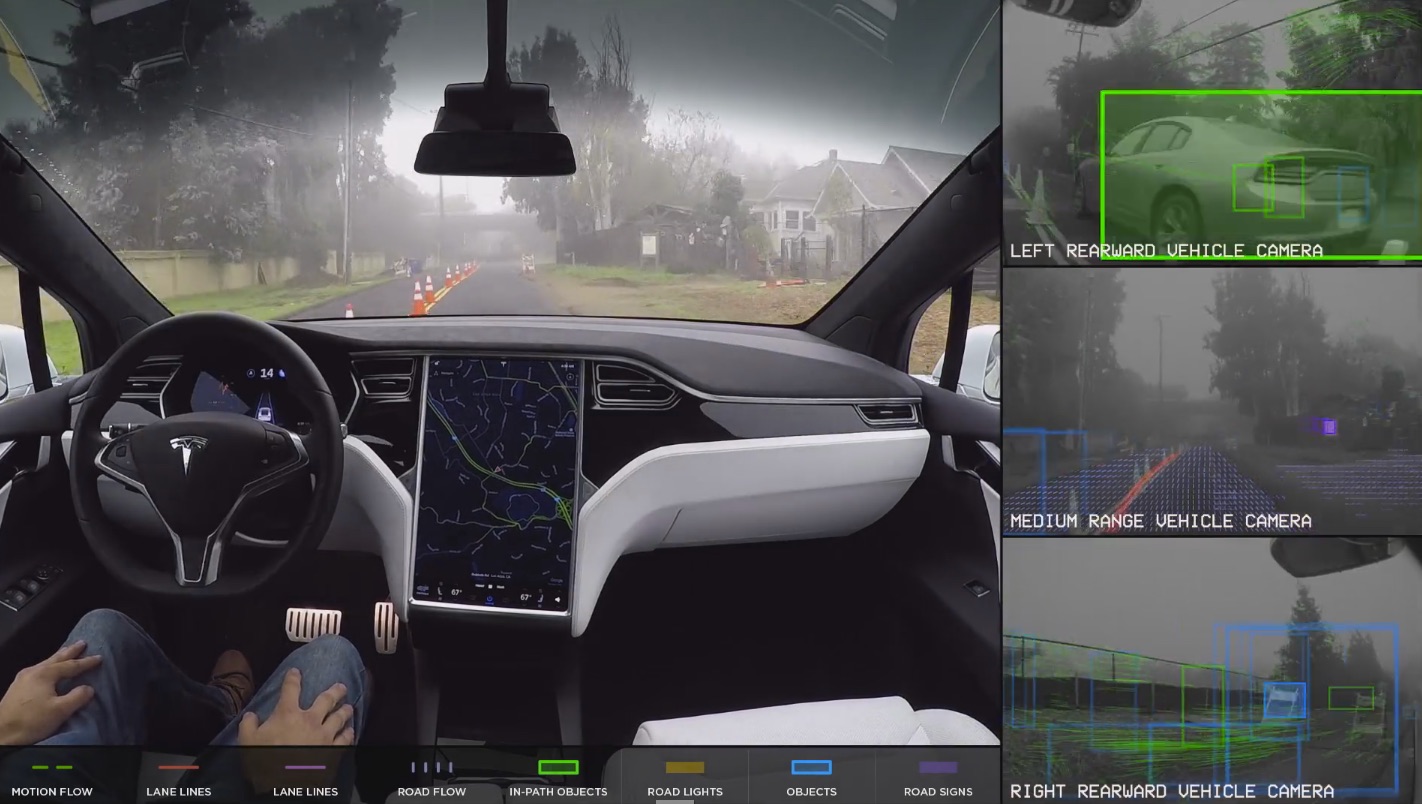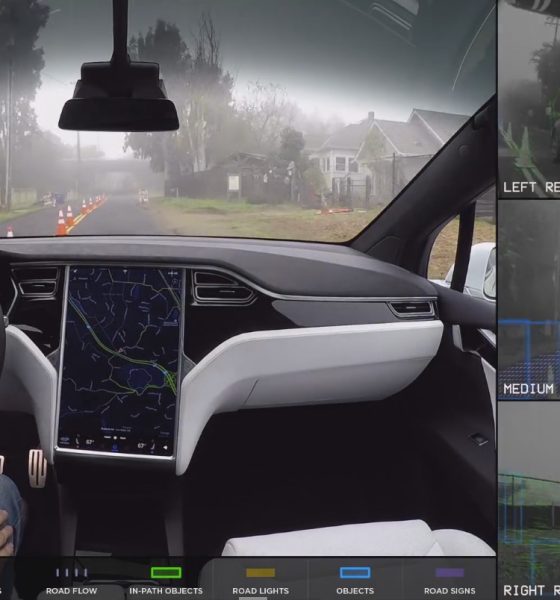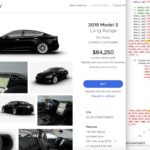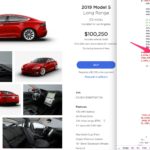

News
Tesla Model S, X with “Hardware 3” for Full Self-Driving now in production, inventory codes indicate
Tesla has begun producing Model X and Model S vehicles with the latest Autopilot hardware to support Full Self-Driving capabilities. Dubbed “HW3”, the new hardware is Tesla’s next iteration of its semi-autonomous driving-assist feature that includes Navigate on Autopilot, Advanced Summon, Auto Lane Change, Autopark, and the ability to respond to traffic lights.
Looking at the source code behind Tesla’s New Inventory site, we’re able to see that recently produced Model S and Model X with Autopilot have been given an “APH4” options code, signifying that these vehicles are equipped with the latest Full Self-Driving hardware. Tesla uses the option code sequence “APHx” to denote the type of Autopilot hardware installed in its vehicles. APH2 indicates HW2 and APH3 = HW2.5 (Autopilot 2.5). Thus, APH4 is HW3.
Here’s a side-by-side comparison of two 2019 Model S with and without the new Hardware 3 for Autopilot.
- 2019 Tesla Model S with Hardware 2.5 (2019 Tesla Model S with “Hardware 3” (APH3)
- 2019 Tesla Model S with “Hardware 3” (APH4)
Source: Tesla New Inventory listing
The tip comes to us from Tesla Info and Inventory, a web site which compiles inventory data for Tesla vehicles around the world, noted that internal vehicle “option codes” indicated a change from Hardware 2.5 to Hardware 3. The site pulls source data directly from Tesla’s car listing pages and analyzes the “config” data embedded in the HTML to determine this information.
This discovery aligns with the schedule for the HW3 installs previously set forth by Tesla CEO Elon Musk. Last October, Musk estimated a 6-month wait before the the new chips would be installed in all new production cars, meaning an April showing.
~6 months before it is in all new production cars. No change to sensors. This is simple replacement of the Autopilot computer. Will be done free of charge for those who ordered full self-driving.
— Elon Musk (@elonmusk) October 16, 2018
Musk has touted HW3 as the “world’s most advanced computer designed specifically” for the purpose of self-driving functionality, with Tesla holding a notable lead in the field overall. “If you add everyone else up combined, they’re probably 5% — I’m being generous — of the miles that Tesla has. And this difference is increasing,” Musk said in Tesla’s 2018 Q4 earnings call.
For vehicles without HW3 installed at the time of manufacture, Musk has stressed the simplicity of the upgrade process in Tesla’s 2018 Q2 earnings call. “We take out one computer and plug in the next. That’s it. All the connectors are compatible and you get an order of magnitude, more processing and you can run all the cameras at primary full resolution with the complex neural net.”
The simple upgrade to HW3 does require Tesla cars to have HW2 as the equipment needed for its functionality was included in those vehicles. The software uses an array of 8 cameras, 12 ultrasonic sensors, and a forward-facing radar paired with Tesla’s vision and neural net system.

The first features of the Full Self-Driving suite were included in the Version 9 software released in October. “Navigate on Autopilot”, an active guidance feature with Autosteer for highway driving (with driver supervision) came soon after with the release of HW2.5. Improvement in performance from software Version 8.1. to 9.0 was increased by about 400% in useful operations per second; however, the difference between V9.0 and HW3 will make a difference of 500-2000%, according to Musk. Tesla has been releasing iterative over-the-air updates over the last year in preparation for the coming HW3 and complete FSD capabilities.
The current iteration of Tesla’s FSD capabilities includes core highway navigation, autopark, and Summon for car retrieval in parking lots. Recognition of traffic signs and signals as well as city street driving are expected to be coming later this year.
Now that HW3 is on its way to current and future Tesla customers, Full Self-Driving certainly feels right around the corner. However, the biggest obstacle to full implementation still sits on the regulation side, a time-consuming yet necessary part of the consumer vehicle industry, especially when a company is handing over responsibility to a computer. Tesla’s Autopilot page still references full self-driving capabilities as something “in the future” that may happen after regulatory approval which “may take longer in some jurisdictions.”
Tesla’s dominance in the all-electric market will most likely work in its favor to overcome the legal hurdles in the way of autonomous driving. As sales continue to rise with the growing number of customers now able to meet more affordable price points, Tesla will keep accumulating useful data to hone its FSD software and make the case for its much-safer-than-humans capabilities. Other companies may have long been battling the same regulatory demons Tesla is now up against, but the electric car was also “killed off” prior to their very influential arrival on the market. In “Musk World”, there is improbable, but not often impossible.

News
Tesla Diner becomes latest target of gloom and doom narrative

The Tesla Diner has been subject to many points of criticism since its launch in mid-2025, and skeptics and disbelievers claim the company’s latest novel concept is on its way down, but there’s a lot of evidence to state that is not the case.
The piece cites anecdotal evidence like empty parking lots, more staff than customers during a December visit, removed novelty items, like Optimus robot popcorn service and certain menu items, the departure of celebrity chef Eric Greenspan in November 2025, slow service, high prices, and a shift in recent Google/Yelp reviews toward disappointment.
The piece frames this as part of broader Tesla struggles, including sales figures and Elon Musk’s polarizing image, calling it a failed branding exercise rather than a sustainable restaurant.
This narrative is overstated and sensationalized, and is a good representation of coverage on Tesla by today’s media.
Novelty Fade is Normal, Not Failure
Any hyped launch, especially a unique Tesla-branded destination blending dining, Supercharging, and a drive-in theater, naturally sees initial crowds taper off after the “Instagram effect” wears down.
Tesla makes major change at Supercharger Diner amid epic demand
This is common for experiential spots in Los Angeles, especially pop-up attractions or celebrity-backed venues. The article admits early success with massive lines and social media buzz, but treats the return to normal operations as “dying down.”
In reality, this stabilization is a healthy sign of transitioning from hype-driven traffic to steady patronage.
Actual Performance Metrics Contradict “Ghost Town” Claims
- In Q4 2025, the Diner generated over $1 million in revenue, exceeding the average McDonald’s location
- It sold over 30,000 burgers and 83,000 fries in that quarter alone. These figures indicate a strong ongoing business, especially for a single-location prototype focused on enhancing Supercharger experiences rather than competing as a mass-market chain
It’s not a ghost town lol. The @Tesla Diner still had over 30,000 burger orders and 83,000 fries orders in Q4. The diner generated over $1M in revenue in Q4, a $4M annual run rate, which is more than the average McDonald’s…. pic.twitter.com/XvAGLUqxej
— Sawyer Merritt (@SawyerMerritt) January 4, 2026
Conflicting On-the-Ground Reports
While the article, and other similar pieces, describe a half-full parking lot and sparse customers during specific off-peak visits, other recent accounts push back:
- A January 2026 X post noted 50 of 80 Supercharger stalls were busy at 11 a.m., calling it “the busiest diner in Hollywood by close to an order of magnitude
TESLA DINER 🍔
Frantic!!!
Crazy busy. pic.twitter.com/wMbmr8SFFn
— Rich & Sharon (@HullTeslaModel3) January 4, 2026
- Reddit discussions around the same time describe it as not empty when locals drive by regularly, with some calling the empty narrative “disingenuous anti-Tesla slop.”
When we visited it last week it was packed. We had to wait to enter, get a table and go to the restroom. We were lucky to find a spot to charge.
— Rani G (@ranig) January 4, 2026
Bottom Line
The Tesla Diner, admittedly, is not the nonstop circus it was at launch–that was never sustainable or intended. But, it’s far from “dying” or an “empty pit stop.”
It functions as a successful prototype: boosting Supercharger usage, generating solid revenue, and serving as a branded amenity in the high-traffic EV market of Los Angeles.
News
Tesla stands to win big from potential adjustment to autonomous vehicle limitations
Enabling scale, innovation, and profitability in a sector that is growing quickly would benefit Tesla significantly, especially as it has established itself as a leader.

Tesla stands to be a big winner from a potential easing of limitations on autonomous vehicle development, as the United States government could back off from the restrictions placed on companies developing self-driving car programs.
The U.S. House Energy and Commerce subcommittee will hold a hearing later this month that will aim to accelerate the deployment of autonomous vehicles. There are several key proposals that could impact the development of self-driving cars and potentially accelerate the deployment of this technology across the country.
These key proposals include raising the NHTSA’s exemption cap from 2,500 to 90,000 vehicles per year per automaker, preempting state-level regulations on autonomous vehicle systems, and mandating NHTSA guidelines for calibrating advanced driver assistance systems (ADAS).
Congress, to this point, has been divided on AV rules, with past bills like the 2017 House-passed measure stalling in the Senate. Recent pushes come from automakers urging the Trump administration to act faster amid competition from Chinese companies.
Companies like Tesla, who launched a Robotaxi service in Austin and the Bay Area last year, and Alphabet’s Waymo are highlighted as potential beneficiaries from lighter sanctions on AV development.
The NHTSA recently pledged to adopt a quicker exemption review for autonomous vehicle companies, and supporters of self-driving tech argue this will boost U.S. innovation, while critics are concerned about safety and job risks.
How Tesla Could Benefit from the Proposed Legislation
Tesla, under CEO Elon Musk’s leadership, has positioned itself as a pioneer in autonomous driving technology with its Full Self-Driving software and ambitious Robotaxi plans, including the Cybercab, which was unveiled in late 2024.
The draft legislation under consideration by the U.S. House subcommittee could provide Tesla with significant advantages, potentially transforming its operational and financial landscape.
NHTSA Exemption Cap Increase
First, the proposed increase in the NHTSA exemption cap from 2,500 to 90,000 vehicles annually would allow Tesla to scale up development dramatically.
Currently, regulatory hurdles limit how many fully autonomous vehicles can hit the roads without exhaustive approvals. For Tesla, this means accelerating the rollout of its robotaxi fleet, which Musk envisions as a network of millions of vehicles generating recurring revenue through ride-hailing. With Tesla’s vast existing fleet of over 6 million vehicles equipped with FSD hardware, a higher cap could enable rapid conversion and deployment, turning parked cars into profit centers overnight.
Preempting State Regulations
A united Federal framework would be created if it could preempt State regulations, eliminating the patchwork of rules that currently complicate interstate operations. Tesla has faced scrutiny and restrictions in states like California, especially as it has faced harsh criticism through imposed testing limits.
A federal override of State-level rules would reduce legal battles, compliance costs, and delays, allowing Tesla to expand services nationwide more seamlessly.
This is crucial for Tesla’s growth strategy, as it operates in multiple markets and aims for a coast-to-coast Robotaxi network, competing directly with Waymo’s city-specific expansions.
Bringing Safety Standards to the Present Day
Innovation in the passenger transportation sector has continued to outpace both State and Federal-level legislation, which has caused a lag in the development of many things, most notably, self-driving technology.
Updating these outdated safety standards, especially waiving requirements for steering wheels or mirrors, directly benefits Tesla’s innovative designs. Tesla wanted to ship Cybertruck without side mirrors, but Federal regulations required the company to equip the pickup with them.
Cybercab is also planned to be released without a steering wheel or pedals, and is tailored for full autonomy, but current rules would mandate human-ready features.
Streamlined NHTSA reviews would further expedite approvals, addressing Tesla’s complaints about bureaucratic slowdowns. In a letter written in June to the Trump Administration, automakers, including Tesla, urged faster action, and this legislation could deliver it.
In Summary
This legislation represents a potential regulatory tailwind for Tesla, but it still relies on the government to put forth action to make things easier from a regulatory perspective. Enabling scale, innovation, and profitability in a sector that is growing quickly would benefit Tesla significantly, especially as it has established itself as a leader.
News
Nvidia CEO Jensen Huang explains difference between Tesla FSD and Alpamayo
“Tesla’s FSD stack is completely world-class,” the Nvidia CEO said.

NVIDIA CEO Jensen Huang has offered high praise for Tesla’s Full Self-Driving (FSD) system during a Q&A at CES 2026, calling it “world-class” and “state-of-the-art” in design, training, and performance.
More importantly, he also shared some insights about the key differences between FSD and Nvidia’s recently announced Alpamayo system.
Jensen Huang’s praise for Tesla FSD
Nvidia made headlines at CES following its announcement of Alpamayo, which uses artificial intelligence to accelerate the development of autonomous driving solutions. Due to its focus on AI, many started speculating that Alpamayo would be a direct rival to FSD. This was somewhat addressed by Elon Musk, who predicted that “they will find that it’s easy to get to 99% and then super hard to solve the long tail of the distribution.”
During his Q&A, Nvidia CEO Jensen Huang was asked about the difference between FSD and Alpamayo. His response was extensive:
“Tesla’s FSD stack is completely world-class. They’ve been working on it for quite some time. It’s world-class not only in the number of miles it’s accumulated, but in the way it’s designed, the way they do training, data collection, curation, synthetic data generation, and all of their simulation technologies.
“Of course, the latest generation is end-to-end Full Self-Driving—meaning it’s one large model trained end to end. And so… Elon’s AD system is, in every way, 100% state-of-the-art. I’m really quite impressed by the technology. I have it, and I drive it in our house, and it works incredibly well,” the Nvidia CEO said.
Nvidia’s platform approach vs Tesla’s integration
Huang also stated that Nvidia’s Alpamayo system was built around a fundamentally different philosophy from Tesla’s. Rather than developing self-driving cars itself, Nvidia supplies the full autonomous technology stack for other companies to use.
“Nvidia doesn’t build self-driving cars. We build the full stack so others can,” Huang said, explaining that Nvidia provides separate systems for training, simulation, and in-vehicle computing, all supported by shared software.
He added that customers can adopt as much or as little of the platform as they need, noting that Nvidia works across the industry, including with Tesla on training systems and companies like Waymo, XPeng, and Nuro on vehicle computing.
“So our system is really quite pervasive because we’re a technology platform provider. That’s the primary difference. There’s no question in our mind that, of the billion cars on the road today, in another 10 years’ time, hundreds of millions of them will have great autonomous capability. This is likely one of the largest, fastest-growing technology industries over the next decade.”
He also emphasized Nvidia’s open approach, saying the company open-sources its models and helps partners train their own systems. “We’re not a self-driving car company. We’re enabling the autonomous industry,” Huang said.










